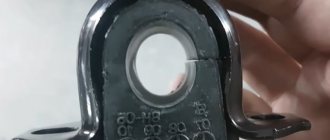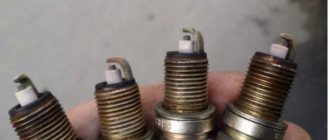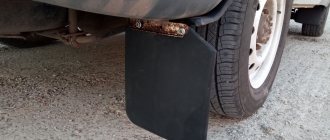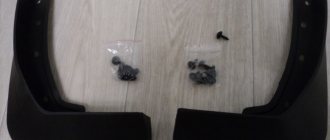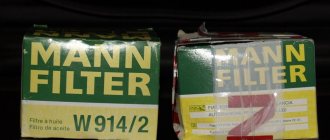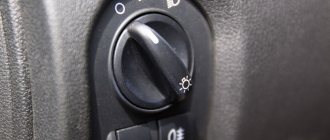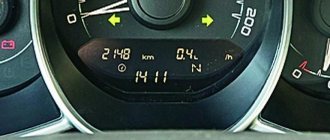Do Lada Vesta need front mudguards?
Front mud flaps (hereinafter referred to as protection) are extremely necessary to prevent the development of corrosion on metal parts of the body, under the wheel arches.
During systematic contact of metal with snow, ice, and chemical reagents that are sprinkled on roads, the paintwork is damaged and the surface oxidizes. Plastic protection reduces the risk of corrosion by 60 - 70%.
Types of mud flaps
Mud flaps (hereinafter referred to as protection) are made of impact-resistant rubber and plastic adapted to temperature changes.
The former are more resistant to damage and wear. The material from which they are made is elastic and does not break when bent, which is very convenient when overcoming road obstacles, uneven surfaces, and potholes.
Plastic accessories are purchased less often than rubber ones. It's not even a matter of price, but the systematic accumulation of dirt and moisture in the grooves of the sidewalls.
Among the advantages of plastic is “holding” its shape when moving at high speeds. At the same time, even a shallow pothole on the road will deform the plastic protection.
Selection of mud flaps for Lada Vesta
The factory equipment of the car includes plastic protection, the dimensions of which are 187 x 154 x 5 mm. The material is practical, but only under conditions of use on a flat road surface, at positive ambient temperatures.
If a wheel gets into a bump and the machine is operated in negative conditions, there is a high probability of damage to the plastic accessory. Therefore, before purchasing protection, evaluate the likely operating environment of the machine.
Products made from rubber are much more practical than their plastic counterparts. Rubber is elastic, adaptable to temperature changes, and not subject to deformation.
The cost of a rubber accessory is 10–15% more expensive than “plastic”, and the service life is 2–3 years longer.
Unlike the factory ones, front mudguards, lengthened by 7 cm, total 194 mm. The increased width of the mudguards prevents dirt from being thrown onto the side members, sills and underbody of the car.
Mud flaps Novline and Elegant are 2 cm shorter, but they also effectively protect metal structures and paintwork from the negative effects of chemicals on the road, from gravel, sand and dirt.
The extended protection is fastened with five self-tapping screws, one of which is fixed perpendicular to the spar.
The final choice of accessory remains with the owner of the technical device. If necessary, consult with service station specialists regarding the compatibility of the protection with the Lada Vesta model.
Rubber models are more resistant to wear
Rubber is an elastic material, bends easily, and does not break when passing obstacles such as storming curbs and/or city road irregularities. Rubber products are easier to clean, do not crack in severe frost, and prevent the accumulation of dirt.
Plastic models “thanks to” some personal “cons” are a little less common. The stationary surface of plastic products contributes to the accumulation of road dirt, increasing the frequency of visits to car wash complexes. At speed, plastic mudguards hold their shape and work effectively at high speeds.
The final choice is made by the owner of the car. The error is corrected effortlessly at a low cost, without leading to consequences.
Enlarged mudguards - watch the video on how to install them. Very helpful.
Do-it-yourself installation of front mudguards on Lada Vesta
Necessary tools for work
- wheel wrench;
- electric drill;
- Phillips head screwdriver;
- metal brush;
- rags;
- new protection kit.
Step-by-step replacement guide
- We place the car over the inspection hole.
- We squeeze the handbrake and turn off the ignition.
- We jack up the front of the car and remove the wheel.
- We clean the protection perimeter with a metal brush from dirt, snow, and ice deposits.
- We unscrew the four screws in the factory design of the mudguard.
- We wipe the surface of the fender liner from moisture and dirt.
- We attach the new accessory, mark the probable location of the holes, drill them with a drill with a drill bit set to “5”. Lubricate with Lithol.
- We screw on the new protection and install the wheel in its original place.
Selection of mud flaps for Lada Vesta SV Cross
At the moment, there are two types of mud flaps on the Lada Vesta SV - plastic and rubber. Traditionally, rubber tires are installed on all VAZ cars. But with the appearance of Vesta on the market, plastic ones also appeared. Let's look at the pros and cons of each model.
Rubber mud flaps are elastic and easily remove ice and snow. But there is a drawback - such mudguards last much less than plastic ones, since in the cold they become rigid and can break off.
Plastic mud flaps retain their shape longer, but snow and ice stick to them more easily, making them more difficult to clean. In addition, if you try to clear snow and receive a strong impact or impact, they can break off. Or, when hitting an obstacle, such as a curb, such a mudguard is more likely to break off than to remain intact. Even with Vesta Cross’s ground clearance of 203 mm, most mudguards become unusable after 1-2 years of operation.
The price for both types of mudguards is approximately the same, so which mudguards are most preferable is up to you to decide.
Article number of mud flaps Lada Vesta SV
We have already asked a question on this topic on our forum. In order to find a Lada Vesta SV mudguard by article number, you need to know the serial number.
Review of Manufacturer Prices
| Serial number/catalogue number | Price in rubles |
| AvtoVAZ Rear 99999218001382 | From 1100 |
| Novline 89108-0-147-2689 | From 1100 - 1200 |
| 89109-73-147-2689 | From 1100 - 1200 |
| Guard VS-ZBLV | From 900 |
| Avtodriver AVTMODEL2 | From 900 |
| AVTMODEL1 | From 900 |
| NLF 52.33.E10 | From 900 |
| *prices are as of May 2021 | |
Conclusion
Installing rear mud flaps is necessary and important to protect the wheel arches of the car. Regarding the material of the accessory, this is a personal matter: rubber or plastic. The decision on the choice is made by the owner of the vehicle.
Workers at a number of certified workshops insist on purchasing rubber protection, which will extend the life of the mudguard to several years.
Few foreign manufacturers equip their cars with mudguards - shields that are attached behind the wheels. AvtoVAZ decided to keep up with trends and produce Vesta without rear mudguards. But many car owners believe that they cannot do without them. Therefore, questions arise regarding how to select and install Lada Vesta mudguards.
Reviews
| № | Positive |
| 1 | Andrey (Avtodrom): the standard protection is installed, there are no special comments. True, I often slow down when crossing puddles so that there is less toss on the side members, sills, and wheel arch. |
| 2 | Sergey (Avtotema): there is not enough width to fully prevent hits. Garage mates advise installing Gard, Novline, Elegant. They are 7 cm longer, which means the likelihood of casting while driving is reduced significantly. |
| 3 | Kirill (Autoreview): the original fender liners have been installed for two years, there are no complaints, they are working on their own. |
| 4 | Alexey (Avtoria): I have plastic protection, I have to drive carefully, don’t drive at speed, and don’t get into potholes. |
| 5 | Alexander (Drom): I installed the defense on my own and completed it in half an hour. There is nothing complicated in the process. |
| 6 | Stanislav (Behind the wheel): the protection is practical, it does not deform in the cold. |
| 7 | Vasily Alekseevich (“5th wheel”): has been playing for several seasons in his native defense, and copes with his task perfectly. |
| Negative | |
| 8 | Vitaly (Avtotema): the quality of plastic for making mudguards is primitive; in cold weather from -15° the material bursts and cracks. |
| 9 | Svyatoslav (Otzovik.net): I didn’t like the standard mudguards right away, so I replaced them with new rubber ones. |
| 10 | Vlad (ProAvto): A year and a half has passed since the purchase of the car, first the left, then the right mudguard burst. |
Which material is better?
The most popular and in demand material for the manufacture of these parts on the Lada Vesta is rubber. This material can withstand various loads well, it is flexible and elastic, not brittle and brittle. The rubber adapts to any conditions dictated by the track; dirt and water easily drain from them.
Rubber accessories do not affect the aerodynamics of the car, as they adjust and change their position depending on the driving speed. The disadvantage of this material for making mud flaps is that the rubber is prone to aging and wear. On average, rubber products need to be replaced every year and a half, as they wear out and become unusable. Rubber can change its properties depending on the ambient temperature. In severe frost, rubber of this type heats up, and such mud flaps often crack and break.
Another option for the Lada Vesta could be plastic linings. The advantage of plastic over rubber is its resistance to any weather conditions. Regardless of the air temperature, plastic mudguards retain the same state of aggregation.
The disadvantages of this material include the tendency to become dirty due to the characteristic shape of the parts. When driving on uneven roads or off-road, plastic mud flaps often break, since they are more rigid than rubber products and are more easily damaged by impacts and strong pressure. Therefore, driving backwards onto a curb or getting the rear wheel into a hole can lead to damage to the plastic.
Most experienced car owners install rear mudguards on Lada Vesta. These simple and inexpensive products can protect your car from many troubles. Mud flaps are very inexpensive and quickly pay for themselves due to effective protection against dirt and prevention of corrosion.
Do-it-yourself installation of mudguards on Vesta SV Cross
Installing mud flaps on Vesta Cross yourself is not difficult and you don’t have to turn to a salon or car service for help.
For installation you need to prepare the following tools:
- Drill;
- Screwdriver;
- A brush to clean individual areas of the car where the mudguards will be attached;
- Jack;
- A wrench suitable for unscrewing a wheel.
First you need to use a jack to raise the car, so it will be easy to remove the wheels. Then you need to remove the wheel and use a brush to wipe the mounting area from dust and dirt, but this must be done carefully so as not to tear off the paint layer.
Photo during installation
To install the accessory, you will need two self-tapping screws, which are usually included in the kit. The holes are standard ones. The instructions, which are also included in the kit, have a diagram according to which you need to drill additional holes using a drill. The drilled areas must be treated with a special liquid to prevent metal corrosion. Next, the accessory is secured, the wheels are installed and the car is lowered.
Some models of mudguards, for example this one, do not require additional holes; it is enough to use standard ones.
